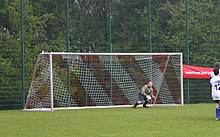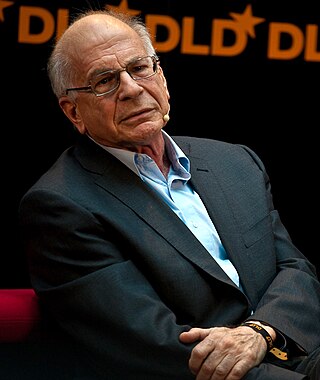Real-world effects
In politics
In politics, action bias is manifested by politicians not taking action on issues such as global warming, but wishing to appear to do so, so they make statements, which are not actually actions, and offer relatively ineffective proposals and implementations. Actions and promises of future actions are not taken primarily to bring about an impactful change, but rather to showcase that one is working on it and progressing. [1] [2] The symbolic power and external image of the action is far more powerful than its true benefit for change. [1] [2]
In medicine
In the field of medicine, action bias can occur in diagnosis and subsequent treatment, which is, among other things, a problem caused by specific diagnostic criteria. If a patient does not meet enough criteria or happens to meet exactly enough criteria, a premature diagnosis or misdiagnosis may be the result. [3] This leads to the patient not receiving satisfactory or needed treatment. One way to counteract the action bias is to use a broader range of tests or to get a second opinion from colleagues and technical experts from relevant fields before making a final diagnosis. [3] In medical decision-making there is the predisposition of professionals to interfere, even if not interfering would be a better option. Here, the action bias takes the name of intervention bias and its existence has been proven by many studies in the medical community. [5]
Action bias occurs among patients as well. When equally presented by a physician with the options of either taking medicine or just resting, most patients greatly prefer taking the medicine. This preference prevails even when patients are warned that the medicine could cause certain side effects or when they are explicitly told that there would be no effect in taking the medicine. [6]
Causes
The causes of intervention bias in medicine are most likely an interplay of two other biases researched in humans: self-interest bias and confirmation bias. [5] Another reason for intervention bias can be found in the fear of malpractice cases, as possible charges can be pressed. [5]
The self-interest bias occurs if a person shows self-serving behaviors and justifies those in favor of their own interests. Medical intervention is partly guided by the financial self-interest of practitioners and the health-care industry. Industry-sponsored studies and analyses can lead to conflicts of interest and biased interpretations of the results. The specialists then make questionable decisions and defend already biased information. [5] Doctors seem to be more satisfied when they have a greater involvement in their patients' treatment, which means that the amount of intervention is closely linked to career happiness and personal gratification. [5] Confirmation bias influences human decision making as sources that confirm one's pre-existing hypotheses are incorporated more readily and preferably than any challenging ideas. Those studies and assessments that justify and promote medical intervention are given more emphasis. Data that contradicts the reviewer's assumptions are either ignored or their own experience and evaluation are viewed as more reliable for the practitioner. [5]
Impacts
Due to the action bias, medical intervention becomes less objective, the physician's primary focus can no longer be the best possible therapy for the patient, possible therapies may be implemented without proper, tailored testing. [5] [7] Other consequences include incorrect and biased medical advice, and additionally physical harm to the patient and collapse of health care systems. [5] Although physicians also have the choice to wait and see if the symptoms subside or intensify and then perform a follow-up check, which would be temporary inaction, instead it is common to perform direct testing and prescription of medication. [3]
In sports

According to some psychologists, the goalkeeper shows an action bias in over 90 percent of the penalty kicks in soccer by diving to either the left or the right. These theorists assert that it is more effective to stand still, or to wait and see which direction the ball is kicked before moving, because guessing wrong will almost guarantee giving up a goal. [8] Researchers surmise that goalkeepers take the risk of guessing because "action" is preferred by their teammates, and success will bring social recognition and other rewards. [8]
However, this analysis ignores game theory and the dynamics of the sport. Because the penalty spot is only 12 yards away, the goalposts are 24 feet apart, the crossbar is 8 feet high, and the ball will be struck with great force, the goalkeeper cannot stand still and wait for the ball to be struck, because they will not have time to reach it. The ball could go to any of the four corners. To have a chance to make a save, the optimum strategy is to guess the target location and begin moving before the opponent's foot touches the ball. This context negates the claim of bias, because the goalkeeper is expected to put in the visible effort to make a save and actively prevent a goal, rather than arrive too late by waiting for directional certainty. Some penalty takers counter this strategy by rolling or chipping the ball down the middle, which is called a Panenka penalty, after a Czech player who made it famous at the UEFA Euro 1976 final.
Action bias is also influenced by previous outcomes. If a team loses a match, the coach is more likely to choose action by changing some of the players, than inaction, even though this might not necessarily lead to a better performance. [4] As expressed by one coach, “Just because I can do something doesn’t mean that I should, or that that activity is relevant.” [9]
In economics and management
Action bias also influences decision-making in the field of economics and management. In the situations where there is an economic downfall, the central banks and governments experience the pressure to take action, as they feel increased scrutiny from the public. As they are expected to fix the situation, action is seen as more appropriate than inaction. Even if the outcome is not successful, by taking action public figures can avoid criticism more easily. [8] In the cases of good economic performance, the authorities are more inclined towards an omission bias as they do not wish to be accused of making the wrong choices that might destroy the current equilibrium. [8] The action/omission bias can be seen in other similar scenarios such as: investors changing their portfolio, switching a company's strategy, applying for a different job, moving to a different city. At the macro-economic level, the action/omission bias comes into play when discussing changes of politics-related variables, such as interest rates, tax rates and various types of expenditures. [8]
In environmental decision-making
The effect of action bias in environmental policy decisions has been investigated by Anthony Patt and Richard Zeckhauser. They argued that action bias is more likely to lead to nonrational decision-making in this domain due to uncertainty and delayed effect of actions, contributions coming from many parties, no effective markets, unclear objectives and few strong incentives. [2] The study concluded that the value of a decision is influenced by one's perceived involvement, individual susceptibility for action bias, as well as framing and context, leading to the occurrence of action bias in environmental policies. [2]








